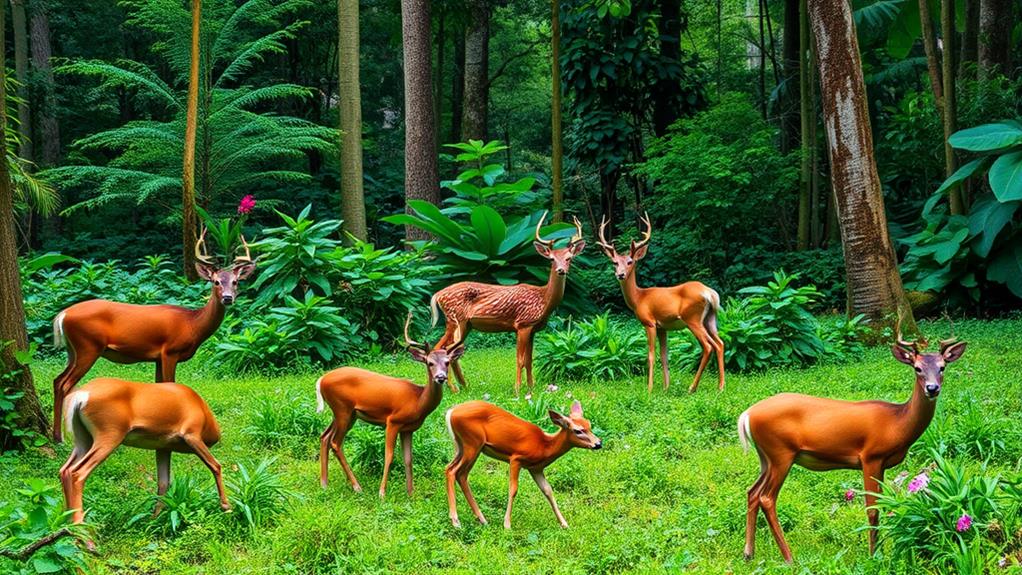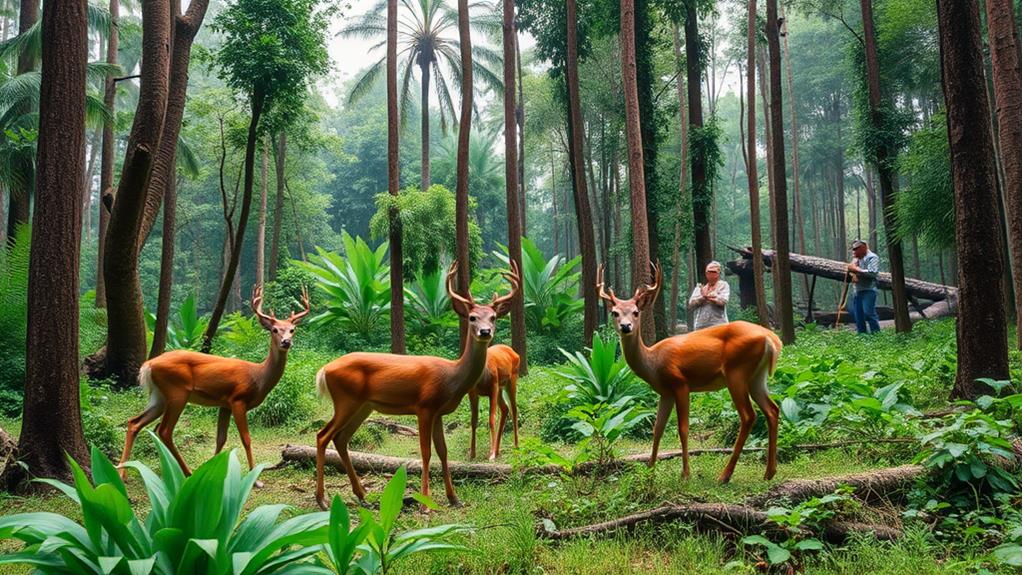The Philippine Deer: Two Main Species
The Philippine deer consists of two main species: the Philippine spotted deer and the Philippine brown deer, both of which are endemic to the islands.
Habitat and Population Decline
These deer inhabit primary and secondary forests, but their populations are dangerously declining.
The main reasons for this decline are habitat loss, hunting, and low reproductive rates.
Conservation Efforts
With only about 700 spotted deer left, urgent conservation efforts are crucial.
Strategies for conservation include community collaboration, habitat restoration, and public awareness campaigns.
Understanding their ecological significance can enhance support for their conservation.
Overview of Philippine Deer Species

Two Main Species of Philippine Deer
The Philippines is home to two primary species of deer: the Philippine spotted deer (Cervus alfredi) and the Philippine brown deer (Rusa marianna). Both species are vulnerable and endemic to the Philippines, with distinct characteristics and significant conservation needs.
Philippine Spotted Deer
The Philippine spotted deer is found primarily in the Visayan Islands and has an estimated population of as few as 700 individuals. Its vulnerable status on the IUCN Red List highlights the urgent need for conservation efforts.
Philippine Brown Deer
In contrast, the Philippine brown deer has a broader distribution across several islands, including Luzon, Mindoro, and Leyte, and has even been introduced to areas like the Federated States of Micronesia.
Shared Characteristics
Both species share a herbivorous diet, primarily consuming grasses, leaves, and fruits. They exhibit nocturnal foraging behavior, which adds an interesting aspect to their survival strategies.
Threats and Conservation Needs
These deer species face critical threats such as habitat loss and fragmentation, hunting pressures, and low fertility rates, resulting in a declining population trend.
Understanding these species' dynamics is key to implementing effective conservation strategies that can help revive their populations before it's too late.
Physical Characteristics and Behavior
Physical Characteristics
The Philippine deer, comprising both the Philippine spotted deer and the Philippine brown deer, have evolved distinct physical traits to thrive in their native habitats. Their slender bodies and brown coloration enable them to blend seamlessly into their forest and grassland environments.
Males possess antlers that range from 20 to 40 cm, which they use to assert dominance during territorial and mating competitions.
Behavior
Philippine deer are predominantly nocturnal, foraging at night to feed on grasses, leaves, and fallen fruits. During the day, they rest in dense thickets for concealment, minimizing the risk of predation and maximizing their foraging efficiency.
During the mating season, which lasts from September to January, females gather in small groups, while males adopt a solitary lifestyle focused on attracting mates and defending their territories.
Reproduction
Philippine deer have a low fertility rate, typically giving birth to a single fawn adorned with light-colored spots. This fawn remains dependent on its mother for about six months, emphasizing the importance of maternal care in the survival of the species.
Understanding these physical characteristics and behaviors is crucial for effective conservation efforts.
Habitat and Distribution

Habitat and Distribution of Philippine Deer
Philippine deer inhabit diverse landscapes across the Philippines. Specifically, species like Cervus alfredi and Rusa marianna are endemic to the Philippines and primarily found on islands such as Luzon, Mindoro, Samar, and Leyte.
They thrive in various environments. These deer favor both primary and secondary forests as well as grasslands, preferring dense cover that provides concealment during their nocturnal activities.
Habitat loss threatens their survival. Deforestation, agricultural expansion, and urban development have led to habitat loss, severely fragmenting their populations and pushing them toward potential extinction in areas like Biliran and Bohol.
This fragmentation not only threatens their numbers but also disrupts their social structures and breeding patterns.
Conservation efforts are crucial. Initiatives focused on habitat protection and sustainable management practices aim to reverse the detrimental impacts of human activities.
By understanding their habitat preferences and distribution, we can contribute to efforts that protect these unique deer and ensure their survival in the rich ecosystems of the Philippine archipelago.
Diet and Feeding Patterns
Philippine deer are herbivores and their diet consists of various vegetation, including grasses, leaves, fallen fruits, and berries. This diet is essential for maintaining their health and reproductive success, particularly during the breeding season.
Their foraging behavior is primarily nocturnal, as they venture out under the cover of darkness to search for food, using the forest shade to stay hidden from predators.
Seasonal changes affect food availability, and the deer adapt their feeding patterns accordingly. During periods of food scarcity, they adjust their foraging strategies to maximize their nutrient intake. For example, they may shift their foraging times or explore new food sources.
Young fawns begin foraging alongside their mothers shortly after weaning, which occurs around six months. This early integration into foraging teaches them essential survival skills and reinforces the species' dietary habits.
Understanding the deer's herbivorous diet and foraging behavior is crucial for grasping how they navigate their environment.
Their ability to adapt to changing conditions is vital for their survival and overall population dynamics. This highlights the importance of conservation efforts to ensure their habitats remain intact.
Population Status and Trends

The Philippine deer population is declining at an alarming rate. Currently, the Philippine spotted deer (Cervus alfredi) and the Philippine brown deer (Rusa marianna) are classified as Vulnerable (VU) on the IUCN Red List. In the last 24 years, their populations have plummeted by over 30%.
There are only around 700 individuals of Cervus alfredi left in the wild, primarily confined to the Visayan Islands.
Habitat loss and fragmentation are the primary drivers of this decline. These environmental disruptions affect the natural habitats of the deer, making it difficult for them to survive.
Low reproductive rates also contribute to the dwindling numbers; females typically give birth to just one fawn, making population recovery challenging. Additionally, hunting threats further exacerbate this situation, as these deer face increasing pressures from illegal hunting practices.
Conservation efforts are necessary to reverse this trend. Ongoing monitoring and habitat protection strategies aim to address the issues at hand and promote the recovery of Philippine deer populations.
Supporting these initiatives is crucial to help secure a future for these magnificent creatures.
Threats to Survival
Threats to the Philippine Deer's Survival
The Philippine deer faces numerous threats that put its survival at risk. Habitat loss and fragmentation are significant contributors to this problem. Deforestation and agricultural expansion have led to the destruction of their natural habitats, reducing food availability and increasing competition for resources.
Intensive hunting is another major threat. Hunters target deer for their meat and antlers, leading to unsustainable harvest levels. The high demand for deer meat, which can cost between PhP150-250 per kilogram, fuels this hunting practice.
Low fertility rates also hinder the deer's ability to recover from population decline. Female Philippine deer typically give birth to only one fawn per gestation period, making it challenging for the population to grow.
Environmental changes and anthropogenic pressures have led to an estimated 30% decline in the Philippine deer population over the last 24 years.
As a result, the International Union for Conservation of Nature (IUCN) has classified the species as Vulnerable (VU). This highlights the need for conservation efforts focused on habitat protection and sustainable management practices to ensure the survival of the Philippine deer in the wild.
Conservation Efforts and Strategies

Conservation Efforts for the Philippine Deer
The decline of the Philippine deer population has prompted the implementation of various conservation programs since 1992, focusing on habitat protection and sustainable management practices.
Collaboration with local communities is crucial, as it reduces hunting pressures and promotes biodiversity preservation by engaging residents in protection efforts.
Public awareness campaigns are essential, as they highlight the ecological importance of the Philippine deer and rally community support for conservation initiatives. Without public buy-in, even the best-laid plans can fail.
Monitoring technologies, such as camera traps and population surveys, provide valuable data, ensuring that conservation strategies remain responsive and effective.
Interdisciplinary research enhances conservation strategies by broadening our understanding of the challenges faced by the Philippine deer in their natural habitats. This collaboration across fields enriches our knowledge and enhances the viability of conservation strategies.
Preserving the Philippine deer requires a multifaceted approach, integrating community engagement, scientific research, and proactive management.
Cultural Significance and Local Beliefs
Cultural Significance of the Philippine Deer
The Philippine deer holds a sacred place in the cultural beliefs and practices of local communities, reflecting a deep connection between nature and cultural identity. In indigenous groups like the Bagobo-Tagabawa, the Philippine brown deer is a cultural keystone species, integral to their traditional rituals and practices. This connection fosters a sense of belonging and emphasizes the deer's ecological importance within its habitat.
Conservation and Cultural Heritage
The Obu Manuvu community regards the deer as a Pusaka species, symbolizing their commitment to conservation as part of their cultural heritage. Local beliefs often celebrate the deer's grace and agility, reinforcing its role in the social fabric of these communities.
To balance cultural practices with conservation needs, some groups have established hunting zones, reflecting an awareness of sustainable practices.
Preserving Cultural Legacy
The cultural significance of the Philippine deer extends beyond mere symbolism; it embodies the values and traditions that shape local identities. By recognizing and preserving this relationship, communities can ensure the ecological and cultural legacy of the Philippine deer continues to thrive for future generations.
Future Directions for Conservation

Effective Conservation Strategies
To successfully conserve the Philippine deer, habitat restoration and protection are crucial to address habitat loss and fragmentation. Engaging local communities, such as the Bagobo-Tagabawa tribe, in conservation initiatives can foster sustainable practices that respect traditional hunting zones while promoting biodiversity.
Raising Public Awareness
Educating the community about the ecological importance of Philippine deer is essential to garner support for conservation efforts and reduce hunting pressures that threaten their survival. This awareness can be achieved through targeted campaigns and outreach programs.
Monitoring and Research
Ongoing monitoring and research are critical to evaluate the success of conservation strategies and adapt methods based on ecological changes. This data-driven approach ensures that conservation efforts remain effective and targeted.
Collaboration and International Support
Collaboration with international conservation organizations can enhance the effectiveness of programs by pooling resources and expertise. This ensures that conservation initiatives are sustainable and impactful in the long run.
A Holistic Approach
The future of Philippine deer conservation relies on a holistic approach that intertwines habitat restoration, community engagement, and scientific research.
Questions and Answers
What Is the Conservation Status of Philippine Deer?
The conservation status of Philippine deer is vulnerable. Habitat loss and significant population decline are the main threats to their survival.
The two species of Philippine deer, the Philippine brown deer and the Philippine spotted deer, are both endangered. This is primarily due to the destruction of their natural habitats, which are being converted into agricultural land, urban areas, and plantations.
Conservation efforts are underway to protect these animals. The Philippine government, in collaboration with local communities and non-governmental organizations, is working to preserve the deer's habitats and prevent further population decline.
Community involvement is crucial in these efforts, as it allows for the integration of traditional knowledge with modern conservation practices. For example, local communities are being trained to monitor deer populations and report any signs of poaching or habitat destruction.
The ecological significance of Philippine deer makes their conservation essential. These animals play a vital role in maintaining the balance of their ecosystems, and their loss could have severe consequences for the environment.
Without concerted conservation efforts, the future of Philippine deer remains uncertain.
Why Is the Philippine Spotted Deer Endangered?
Habitat loss and poaching are the primary threats to the Philippine Spotted Deer's survival. The destruction of their natural habitats has led to a significant decline in their population, while poaching has further exacerbated the problem.
Low fertility rates hinder breeding programs. Conservation efforts are hindered by the deer's low reproductive rate, making it challenging to increase their population.
The Philippine Spotted Deer plays a vital ecological role. As a key species in their ecosystem, their loss could have far-reaching and devastating consequences for the environment.
Raising local awareness and implementing government policies are crucial.
Stronger government policies and community involvement are essential to protect the Philippine Spotted Deer and their habitats.
Education and awareness campaigns can increase local understanding of the species' importance and encourage action to conserve them.
What Is the Rarest Deer Species in the Philippines?
The rarest deer species in the Philippines is the Calamian deer.
This species is critically endangered, with a population of only around 700 individuals. The main reason for this is habitat loss, which has led to the destruction of its sustainable habitats, including grasslands and mangroves.
Poaching is another significant threat to the Calamian deer's survival. This illegal activity not only reduces the population but also risks the deer's genetic diversity.
To combat these threats, community involvement in conservation strategies is essential. By working together, we can protect the deer and maintain their ecological roles within their historical range, ensuring their survival for future generations.
What Is the Visayan Spotted Deer Conservation Program?
The Visayan Spotted Deer Conservation Program has a multi-faceted approach to protect this critically endangered species.
Habitat protection is a crucial element, which involves creating wildlife corridors to connect fragmented habitats and allow the deer to roam freely.
Additionally, breeding programs are enhanced to increase the population and genetic diversity of the species.
Community involvement is vital in the conservation effort.
Local residents are engaged in ecological education to raise awareness about the importance of conservation and the impact of human activities on the deer's habitat.
They're also involved in anti-poaching efforts, helping to prevent hunting and protect the deer from harm.
Ongoing research initiatives monitor population trends, tracking the growth or decline of the deer population and identifying factors that affect it.
This information is used to adapt conservation strategies to changing conditions, ensuring the program remains effective.
The ultimate goal of the Visayan Spotted Deer Conservation Program is to secure the future of the species in its natural habitat, ensuring the long-term survival of this critically endangered deer.